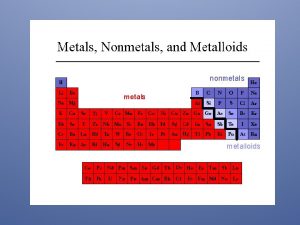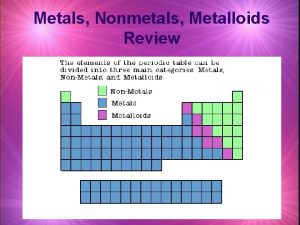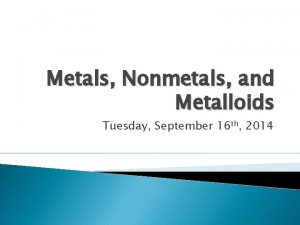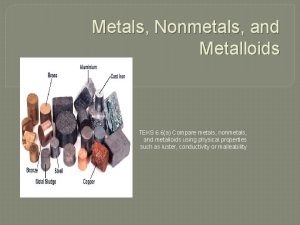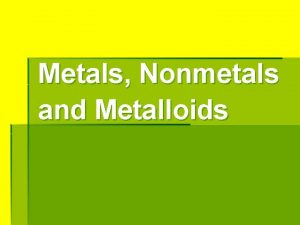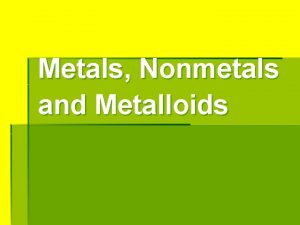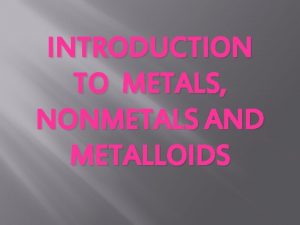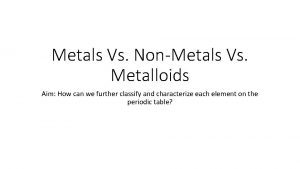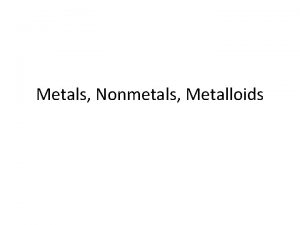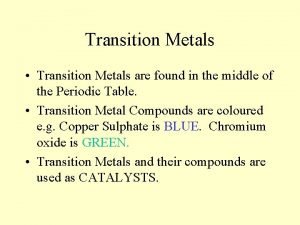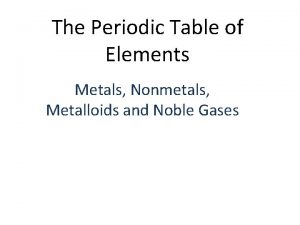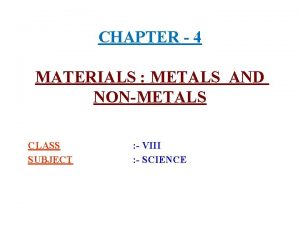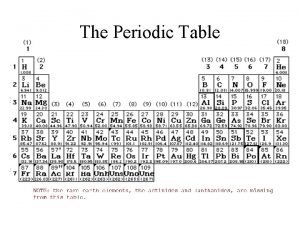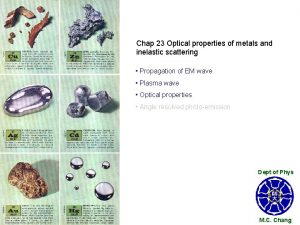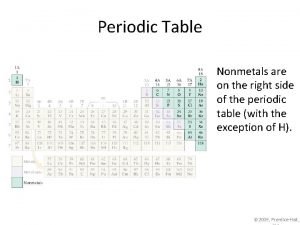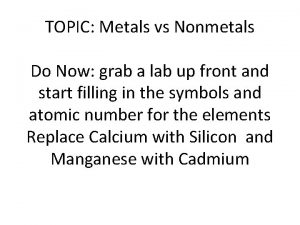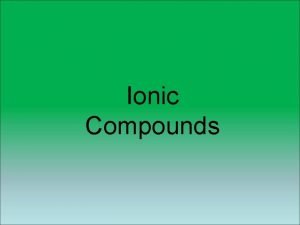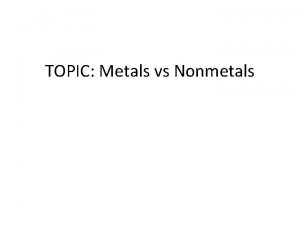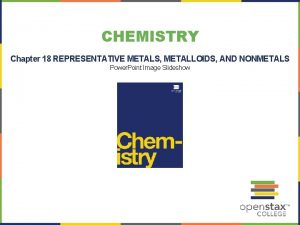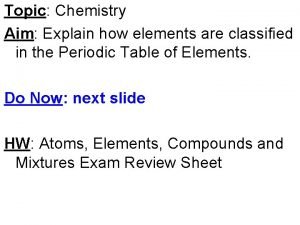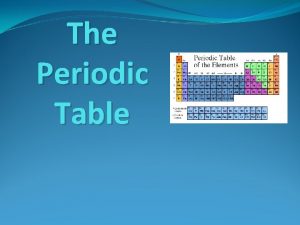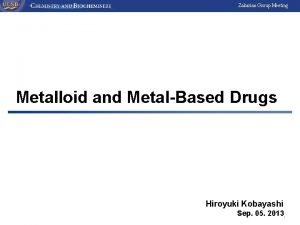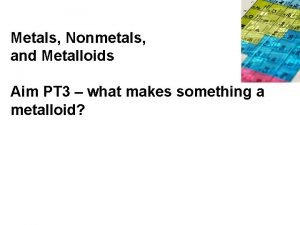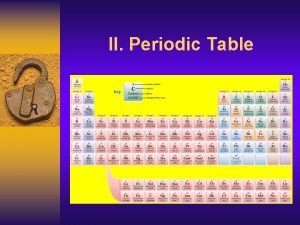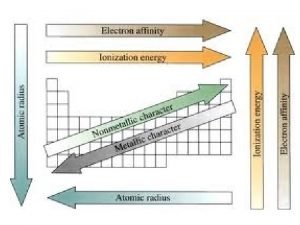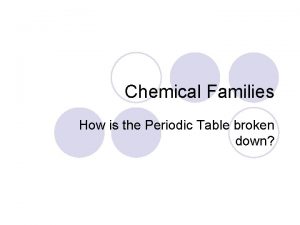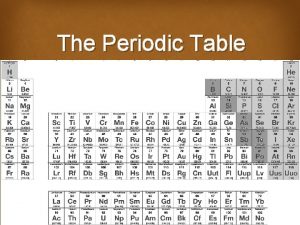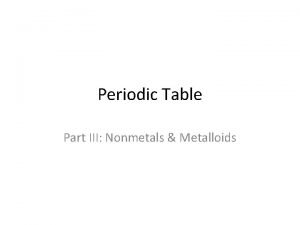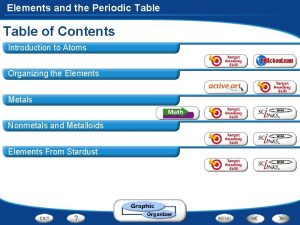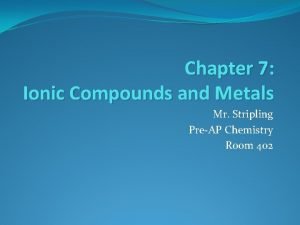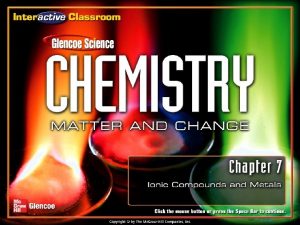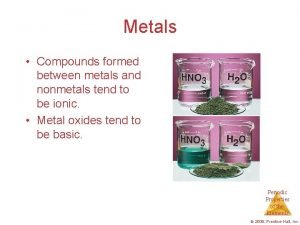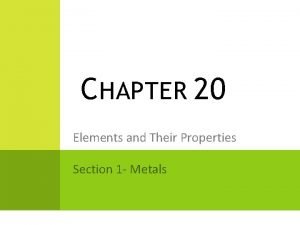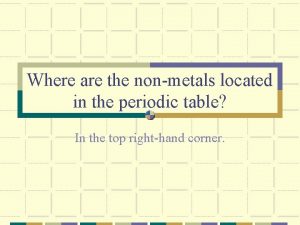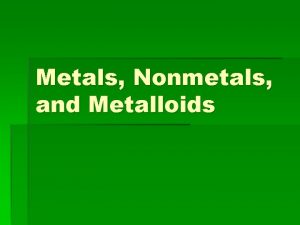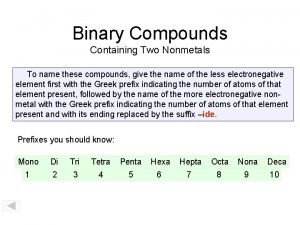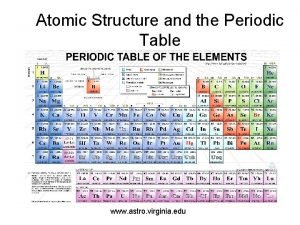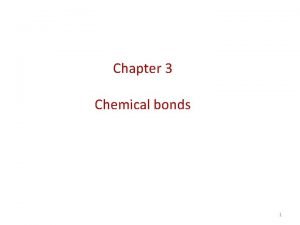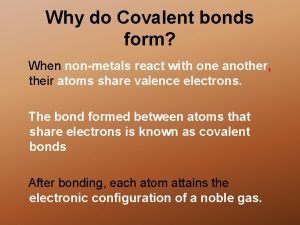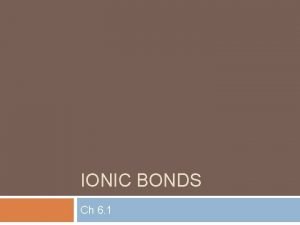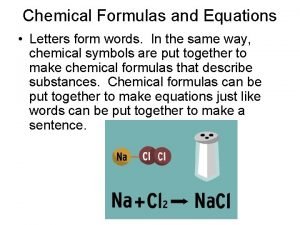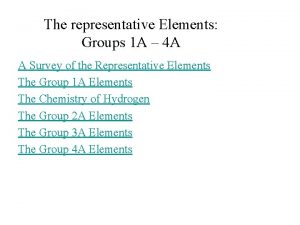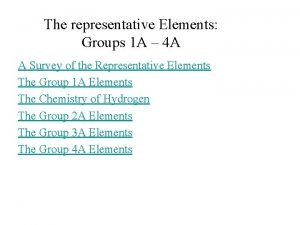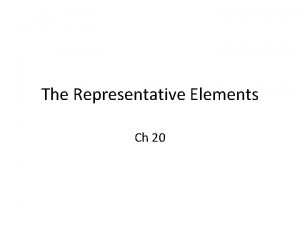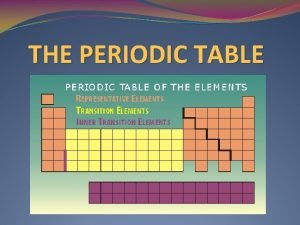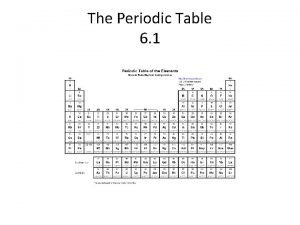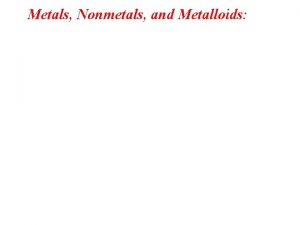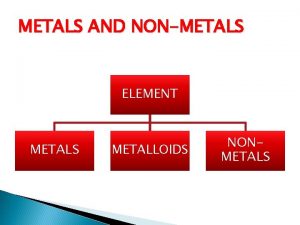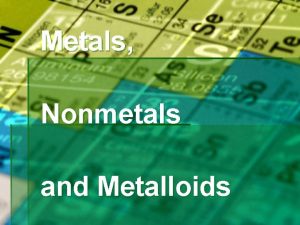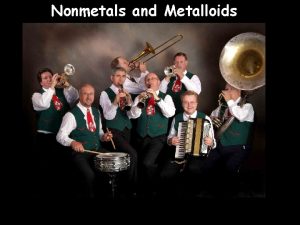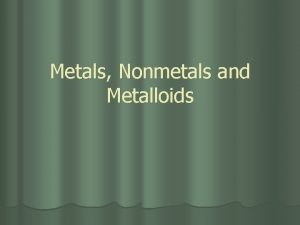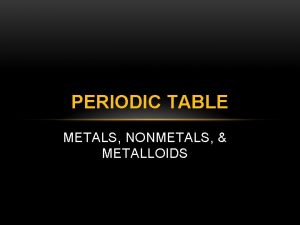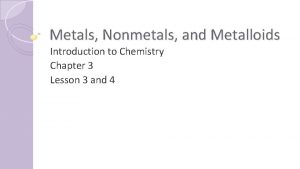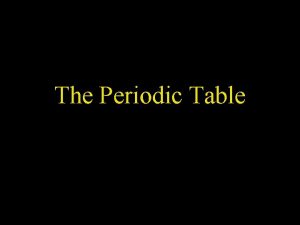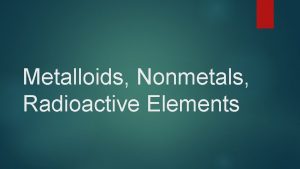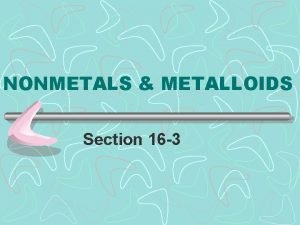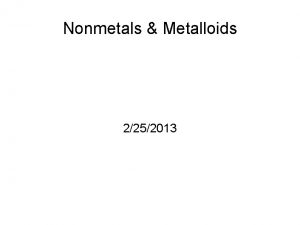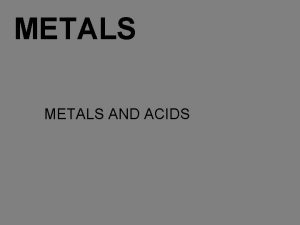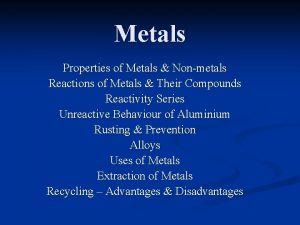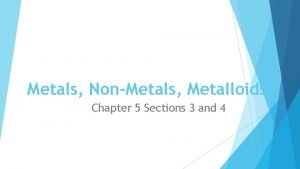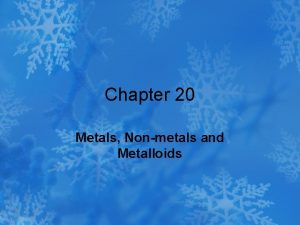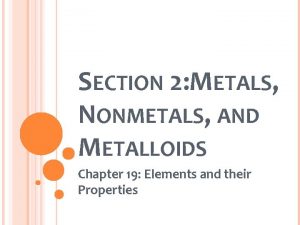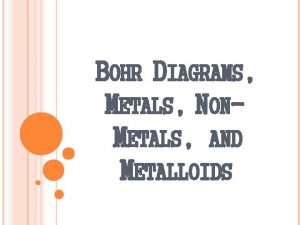CHEMISTRY Chapter 18 REPRESENTATIVE METALS METALLOIDS AND NONMETALS


































































- Slides: 66

CHEMISTRY Chapter 18 REPRESENTATIVE METALS, METALLOIDS, AND NONMETALS Power. Point Image Slideshow

FIGURE 18. 1 Purity is extremely important when preparing silicon wafers. Technicians in a cleanroom prepare silicon without impurities (left). The CEO of VLSI Research, Don Hutcheson, shows off a pure silicon wafer (center). A silicon wafer covered in Pentium chips is an enlarged version of the silicon wafers found in many electronics used today (right). (credit middle: modification of work by “Intel Free Press”/Flickr; credit right: modification of work by Naotake Murayama) This Open. Stax ancillary resource is © Rice University under a CC-BY 4. 0 International license; it may be reproduced or modified but must be attributed to Open. Stax, Rice University and any changes must be noted. Any images credited to other sources are similarly available for reproduction, but must be attributed to their sources.

FIGURE 18. 2 The location of the representative metals is shown in the periodic table. Nonmetals are shown in green, metalloids in purple, and the transition metals and inner transition metals in yellow. This Open. Stax ancillary resource is © Rice University under a CC-BY 4. 0 International license; it may be reproduced or modified but must be attributed to Open. Stax, Rice University and any changes must be noted. Any images credited to other sources are similarly available for reproduction, but must be attributed to their sources.

FIGURE 18. 3 Lithium floats in paraffin oil because its density is less than the density of paraffin oil. This Open. Stax ancillary resource is © Rice University under a CC-BY 4. 0 International license; it may be reproduced or modified but must be attributed to Open. Stax, Rice University and any changes must be noted. Any images credited to other sources are similarly available for reproduction, but must be attributed to their sources.

FIGURE 18. 4 To prevent contact with air and water, potassium for laboratory use comes as sticks or beads stored under kerosene or mineral oil, or in sealed containers. (credit: http: //images-of-elements. com/potassium. php) This Open. Stax ancillary resource is © Rice University under a CC-BY 4. 0 International license; it may be reproduced or modified but must be attributed to Open. Stax, Rice University and any changes must be noted. Any images credited to other sources are similarly available for reproduction, but must be attributed to their sources.

FIGURE 18. 5 Dipping a wire into a solution of a sodium salt and then heating the wire causes emission of a bright yellow light, characteristic of sodium. This Open. Stax ancillary resource is © Rice University under a CC-BY 4. 0 International license; it may be reproduced or modified but must be attributed to Open. Stax, Rice University and any changes must be noted. Any images credited to other sources are similarly available for reproduction, but must be attributed to their sources.

FIGURE 18. 6 From left to right: Mg(s), warm water at p. H 7, and the resulting solution with a p. H greater than 7, as indicated by the pink color of the phenolphthalein indicator. (credit: modification of work by Sahar Atwa) This Open. Stax ancillary resource is © Rice University under a CC-BY 4. 0 International license; it may be reproduced or modified but must be attributed to Open. Stax, Rice University and any changes must be noted. Any images credited to other sources are similarly available for reproduction, but must be attributed to their sources.

FIGURE 18. 7 Zinc is an active transition metal. It dissolves in hydrochloric acid, forming a solution of colorless Zn 2+ ions, Cl– ions, and hydrogen gas. This Open. Stax ancillary resource is © Rice University under a CC-BY 4. 0 International license; it may be reproduced or modified but must be attributed to Open. Stax, Rice University and any changes must be noted. Any images credited to other sources are similarly available for reproduction, but must be attributed to their sources.

FIGURE 18. 8 From left to right: Hg(l), Hg + concentrated HCl, Hg + concentrated HNO 3. (credit: Sahar Atwa) This Open. Stax ancillary resource is © Rice University under a CC-BY 4. 0 International license; it may be reproduced or modified but must be attributed to Open. Stax, Rice University and any changes must be noted. Any images credited to other sources are similarly available for reproduction, but must be attributed to their sources.

FIGURE 18. 9 (a) Tin(II) chloride is an ionic solid; (b) tin(IV) chloride is a covalent liquid. This Open. Stax ancillary resource is © Rice University under a CC-BY 4. 0 International license; it may be reproduced or modified but must be attributed to Open. Stax, Rice University and any changes must be noted. Any images credited to other sources are similarly available for reproduction, but must be attributed to their sources.

FIGURE 18. 10 Pure sodium metal is isolated by electrolysis of molten sodium chloride using a Downs cell. It is not possible to isolate sodium by electrolysis of aqueous solutions of sodium salts because hydrogen ions are more easily reduced than are sodium ions; as a result, hydrogen gas forms at the cathode instead of the desired sodium metal. The high temperature required to melt Na. Cl means that liquid sodium metal forms. This Open. Stax ancillary resource is © Rice University under a CC-BY 4. 0 International license; it may be reproduced or modified but must be attributed to Open. Stax, Rice University and any changes must be noted. Any images credited to other sources are similarly available for reproduction, but must be attributed to their sources. +

FIGURE 18. 11 An electrolytic cell is used for the production of aluminum. The electrolysis of a solution of cryolite and calcium fluoride results in aluminum metal at the cathode, and oxygen, carbon monoxide, and carbon dioxide at the anode. This Open. Stax ancillary resource is © Rice University under a CC-BY 4. 0 International license; it may be reproduced or modified but must be attributed to Open. Stax, Rice University and any changes must be noted. Any images credited to other sources are similarly available for reproduction, but must be attributed to their sources.

FIGURE 18. 12 (a) Arsenic and (b) antimony have a layered structure similar to that of (c) graphite, except that the layers are puckered rather than planar. (d) Elemental tellurium forms spiral chains. This Open. Stax ancillary resource is © Rice University under a CC-BY 4. 0 International license; it may be reproduced or modified but must be attributed to Open. Stax, Rice University and any changes must be noted. Any images credited to other sources are similarly available for reproduction, but must be attributed to their sources.

FIGURE 18. 13 An icosahedron is a symmetrical, solid shape with 20 faces, each of which is an equilateral triangle. The faces meet at 12 corners. This Open. Stax ancillary resource is © Rice University under a CC-BY 4. 0 International license; it may be reproduced or modified but must be attributed to Open. Stax, Rice University and any changes must be noted. Any images credited to other sources are similarly available for reproduction, but must be attributed to their sources.

FIGURE 18. 14 A zone-refining apparatus used to purify silicon. This Open. Stax ancillary resource is © Rice University under a CC-BY 4. 0 International license; it may be reproduced or modified but must be attributed to Open. Stax, Rice University and any changes must be noted. Any images credited to other sources are similarly available for reproduction, but must be attributed to their sources.

This Open. Stax ancillary resource is © Rice University under a CC-BY 4. 0 International license; it may be reproduced or modified but must be attributed to Open. Stax, Rice University and any changes must be noted. Any images credited to other sources are similarly available for reproduction, but must be attributed to their sources.

FIGURE 18. 15 Laboratory glassware, such as Pyrex and Kimax, is made of borosilicate glass because it does not break when heated. The inclusion of borates in the glass helps to mediate the effects of thermal expansion and contraction. This reduces the likelihood of thermal shock, which causes silicate glass to crack upon rapid heating or cooling. (credit: “Tweenk”/Wikimedia Commons) This Open. Stax ancillary resource is © Rice University under a CC-BY 4. 0 International license; it may be reproduced or modified but must be attributed to Open. Stax, Rice University and any changes must be noted. Any images credited to other sources are similarly available for reproduction, but must be attributed to their sources.

FIGURE 18. 16 Boric acid has a planar structure with three –OH groups spread out equally at 120° angles from each other. This Open. Stax ancillary resource is © Rice University under a CC-BY 4. 0 International license; it may be reproduced or modified but must be attributed to Open. Stax, Rice University and any changes must be noted. Any images credited to other sources are similarly available for reproduction, but must be attributed to their sources.

FIGURE 18. 17 The borate anions are (a) Ca. B 2 O 4, (b) KB 5 O 8⋅4 H 2 O, and (c) Na 2 B 4 O 7⋅10 H 2 O. The anion in Ca. B 2 O 4 is an “infinite” chain. This Open. Stax ancillary resource is © Rice University under a CC-BY 4. 0 International license; it may be reproduced or modified but must be attributed to Open. Stax, Rice University and any changes must be noted. Any images credited to other sources are similarly available for reproduction, but must be attributed to their sources.

FIGURE 18. 18 Because carbon tends to form double and triple bonds and silicon does not, (a) carbon dioxide is a discrete molecule with two C=O double bonds and (b) silicon dioxide is an infinite network of oxygen atoms bridging between silicon atoms with each silicon atom possessing four Si-O single bonds. (credit a photo: modification of work by Erica Gerdes; credit b photo: modification of work by Didier Descouens) This Open. Stax ancillary resource is © Rice University under a CC-BY 4. 0 International license; it may be reproduced or modified but must be attributed to Open. Stax, Rice University and any changes must be noted. Any images credited to other sources are similarly available for reproduction, but must be attributed to their sources.

FIGURE 18. 19 Nonmetals exhibit these common oxidation states in ionic and covalent compounds. This Open. Stax ancillary resource is © Rice University under a CC-BY 4. 0 International license; it may be reproduced or modified but must be attributed to Open. Stax, Rice University and any changes must be noted. Any images credited to other sources are similarly available for reproduction, but must be attributed to their sources.

FIGURE 18. 20 (a) Diamond and (b) graphite are two forms of carbon. (c) In the crystal structure of diamond, the covalent bonds form three-dimensional tetrahedrons. (d) In the crystal structure of graphite, each planar layer is composed of six-membered rings. (credit a: modification of work by “Fancy Diamonds”/Flickr; credit b: modification of work from http: //images-ofelements. com/carbon. php) This Open. Stax ancillary resource is © Rice University under a CC-BY 4. 0 International license; it may be reproduced or modified but must be attributed to Open. Stax, Rice University and any changes must be noted. Any images credited to other sources are similarly available for reproduction, but must be attributed to their sources.

FIGURE 18. 21 (a) Carbon atoms in graphite have unhybridized p orbitals. Each p orbital is perpendicular to the plane of carbon atoms. (b) These are two of the many resonance forms of graphite necessary to describe its electronic structure as a resonance hybrid. This Open. Stax ancillary resource is © Rice University under a CC-BY 4. 0 International license; it may be reproduced or modified but must be attributed to Open. Stax, Rice University and any changes must be noted. Any images credited to other sources are similarly available for reproduction, but must be attributed to their sources.

FIGURE 18. 22 The molecular structure of C 60, buckminsterfullerene, is icosahedral. This Open. Stax ancillary resource is © Rice University under a CC-BY 4. 0 International license; it may be reproduced or modified but must be attributed to Open. Stax, Rice University and any changes must be noted. Any images credited to other sources are similarly available for reproduction, but must be attributed to their sources.

FIGURE 18. 23 (a) Graphene and (b) carbon nanotubes are both allotropes of carbon. This Open. Stax ancillary resource is © Rice University under a CC-BY 4. 0 International license; it may be reproduced or modified but must be attributed to Open. Stax, Rice University and any changes must be noted. Any images credited to other sources are similarly available for reproduction, but must be attributed to their sources.

FIGURE 18. 24 (a) Because white phosphorus bursts into flame in air, it is stored in water. (b) The structure of white phosphorus consists of P 4 molecules arranged in a tetrahedron. (c) Red phosphorus is much less reactive than is white phosphorus. (d) The structure of red phosphorus consists of networks of P 4 tetrahedra joined by P-P single bonds. (credit a: modification of work from http: //images-of-elements. com/phosphorus. php) This Open. Stax ancillary resource is © Rice University under a CC-BY 4. 0 International license; it may be reproduced or modified but must be attributed to Open. Stax, Rice University and any changes must be noted. Any images credited to other sources are similarly available for reproduction, but must be attributed to their sources.

FIGURE 18. 25 These four sulfur allotropes show eight-membered, puckered rings. Each sulfur atom bonds to each of its two neighbors in the ring by covalent S-S single bonds. Here are (a) individual S 8 rings, (b) S 8 chains formed when the rings open, (c) longer chains formed by adding sulfur atoms to S 8 chains, and (d) part of the very long sulfur chains formed at higher temperatures. This Open. Stax ancillary resource is © Rice University under a CC-BY 4. 0 International license; it may be reproduced or modified but must be attributed to Open. Stax, Rice University and any changes must be noted. Any images credited to other sources are similarly available for reproduction, but must be attributed to their sources.

FIGURE 18. 26 The electrolysis of water produces hydrogen and oxygen. Because there are twice as many hydrogen atoms as oxygen atoms and both elements are diatomic, there is twice the volume of hydrogen produced at the cathode as there is oxygen produced at the anode. This Open. Stax ancillary resource is © Rice University under a CC-BY 4. 0 International license; it may be reproduced or modified but must be attributed to Open. Stax, Rice University and any changes must be noted. Any images credited to other sources are similarly available for reproduction, but must be attributed to their sources.

FIGURE 18. 27 The reaction of iron with an acid produces hydrogen. Here, iron reacts with hydrochloric acid. (credit: Mark Ott) This Open. Stax ancillary resource is © Rice University under a CC-BY 4. 0 International license; it may be reproduced or modified but must be attributed to Open. Stax, Rice University and any changes must be noted. Any images credited to other sources are similarly available for reproduction, but must be attributed to their sources.

FIGURE 18. 28 Before the fleet’s retirement in 2011, liquid hydrogen and liquid oxygen were used in the three main engines of a space shuttle. Two compartments in the large tank held these liquids until the shuttle was launched. (credit: “reynermedia”/Flickr) This Open. Stax ancillary resource is © Rice University under a CC-BY 4. 0 International license; it may be reproduced or modified but must be attributed to Open. Stax, Rice University and any changes must be noted. Any images credited to other sources are similarly available for reproduction, but must be attributed to their sources.

FIGURE 18. 29 The structure of ammonia is shown with a central nitrogen atom and three hydrogen atoms. This Open. Stax ancillary resource is © Rice University under a CC-BY 4. 0 International license; it may be reproduced or modified but must be attributed to Open. Stax, Rice University and any changes must be noted. Any images credited to other sources are similarly available for reproduction, but must be attributed to their sources.

This Open. Stax ancillary resource is © Rice University under a CC-BY 4. 0 International license; it may be reproduced or modified but must be attributed to Open. Stax, Rice University and any changes must be noted. Any images credited to other sources are similarly available for reproduction, but must be attributed to their sources.

FIGURE 18. 30 (a) Stalactites and (b) stalagmites are cave formations of calcium carbonate. (credit a: modification of work by Arvind Govindaraj; credit b: modification of work by the National Park Service. ) This Open. Stax ancillary resource is © Rice University under a CC-BY 4. 0 International license; it may be reproduced or modified but must be attributed to Open. Stax, Rice University and any changes must be noted. Any images credited to other sources are similarly available for reproduction, but must be attributed to their sources.

FIGURE 18. 31 The reaction of calcium carbonate with hydrochloric acid is shown. (credit: Mark Ott) This Open. Stax ancillary resource is © Rice University under a CC-BY 4. 0 International license; it may be reproduced or modified but must be attributed to Open. Stax, Rice University and any changes must be noted. Any images credited to other sources are similarly available for reproduction, but must be attributed to their sources.

FIGURE 18. 32 All living organisms require nitrogen. A few microorganisms are able to process atmospheric nitrogen using nitrogen fixation. (credit “roots”: modification of work by the United States Department of Agriculture; credit “root nodules”: modification of work by Louisa Howard) This Open. Stax ancillary resource is © Rice University under a CC-BY 4. 0 International license; it may be reproduced or modified but must be attributed to Open. Stax, Rice University and any changes must be noted. Any images credited to other sources are similarly available for reproduction, but must be attributed to their sources.

FIGURE 18. 33 Nitrous oxide, N 2 O, is an anesthetic that has these molecular (left) and resonance (right) structures. This Open. Stax ancillary resource is © Rice University under a CC-BY 4. 0 International license; it may be reproduced or modified but must be attributed to Open. Stax, Rice University and any changes must be noted. Any images credited to other sources are similarly available for reproduction, but must be attributed to their sources.

FIGURE 18. 34 This shows the equilibrium between NO and N 2 O 2. The molecule, N 2 O 2, absorbs light. This Open. Stax ancillary resource is © Rice University under a CC-BY 4. 0 International license; it may be reproduced or modified but must be attributed to Open. Stax, Rice University and any changes must be noted. Any images credited to other sources are similarly available for reproduction, but must be attributed to their sources.

FIGURE 18. 35 Dinitrogen trioxide, N 2 O 3, only exists in liquid or solid states and has these molecular (left) and resonance (right) structures. This Open. Stax ancillary resource is © Rice University under a CC-BY 4. 0 International license; it may be reproduced or modified but must be attributed to Open. Stax, Rice University and any changes must be noted. Any images credited to other sources are similarly available for reproduction, but must be attributed to their sources.

FIGURE 18. 36 The reaction of copper metal with concentrated HNO 3 produces a solution of Cu(NO 3)2 and brown fumes of NO 2. (credit: modification of work by Mark Ott) This Open. Stax ancillary resource is © Rice University under a CC-BY 4. 0 International license; it may be reproduced or modified but must be attributed to Open. Stax, Rice University and any changes must be noted. Any images credited to other sources are similarly available for reproduction, but must be attributed to their sources.

FIGURE 18. 37 The molecular and resonance structures for nitrogen dioxide (NO 2, left) and dinitrogen tetraoxide (N 2 O 4, right) are shown. This Open. Stax ancillary resource is © Rice University under a CC-BY 4. 0 International license; it may be reproduced or modified but must be attributed to Open. Stax, Rice University and any changes must be noted. Any images credited to other sources are similarly available for reproduction, but must be attributed to their sources.

FIGURE 18. 38 This image shows the molecular structure and one resonance structure of a molecule of dinitrogen pentaoxide, N 2 O 5. This Open. Stax ancillary resource is © Rice University under a CC-BY 4. 0 International license; it may be reproduced or modified but must be attributed to Open. Stax, Rice University and any changes must be noted. Any images credited to other sources are similarly available for reproduction, but must be attributed to their sources.

FIGURE 18. 39 P 4 S 3 is a component of the heads of strike-anywhere matches. This Open. Stax ancillary resource is © Rice University under a CC-BY 4. 0 International license; it may be reproduced or modified but must be attributed to Open. Stax, Rice University and any changes must be noted. Any images credited to other sources are similarly available for reproduction, but must be attributed to their sources.

FIGURE 18. 40 This image shows the molecular structures of P 4 O 6 (left) and P 4 O 10 (right). This Open. Stax ancillary resource is © Rice University under a CC-BY 4. 0 International license; it may be reproduced or modified but must be attributed to Open. Stax, Rice University and any changes must be noted. Any images credited to other sources are similarly available for reproduction, but must be attributed to their sources.

FIGURE 18. 41 This image shows the molecular structure of PCl 3 (left) and PCl 5 (right) in the gas phase. This Open. Stax ancillary resource is © Rice University under a CC-BY 4. 0 International license; it may be reproduced or modified but must be attributed to Open. Stax, Rice University and any changes must be noted. Any images credited to other sources are similarly available for reproduction, but must be attributed to their sources.

FIGURE 18. 42 The image shows the bent ozone (O 3) molecule and the resonance structures necessary to describe its bonding. This Open. Stax ancillary resource is © Rice University under a CC-BY 4. 0 International license; it may be reproduced or modified but must be attributed to Open. Stax, Rice University and any changes must be noted. Any images credited to other sources are similarly available for reproduction, but must be attributed to their sources.

FIGURE 18. 43 Calcium oxide has many industrial uses. When it is heated at high temperatures, it emits an intense white light. This Open. Stax ancillary resource is © Rice University under a CC-BY 4. 0 International license; it may be reproduced or modified but must be attributed to Open. Stax, Rice University and any changes must be noted. Any images credited to other sources are similarly available for reproduction, but must be attributed to their sources.

FIGURE 18. 44 Zinc oxide protects exposed skin from sunburn. (credit: modification of work by “osseous”/Flickr) This Open. Stax ancillary resource is © Rice University under a CC-BY 4. 0 International license; it may be reproduced or modified but must be attributed to Open. Stax, Rice University and any changes must be noted. Any images credited to other sources are similarly available for reproduction, but must be attributed to their sources.

FIGURE 18. 45 (a) Mixing solutions of Na. OH and Zn(NO 3)2 produces a white precipitate of Zn(OH)2. (b) Addition of an excess of Na. OH results in dissolution of the precipitate. (credit: modification of work by Mark Ott) This Open. Stax ancillary resource is © Rice University under a CC-BY 4. 0 International license; it may be reproduced or modified but must be attributed to Open. Stax, Rice University and any changes must be noted. Any images credited to other sources are similarly available for reproduction, but must be attributed to their sources.

FIGURE 18. 46 Calcium carbonate, Ca. CO 3, can be consumed in the form of an antacid to neutralize the effects of acid in your stomach. (credit: “Midnightcomm”/Wikimedia Commons) This Open. Stax ancillary resource is © Rice University under a CC-BY 4. 0 International license; it may be reproduced or modified but must be attributed to Open. Stax, Rice University and any changes must be noted. Any images credited to other sources are similarly available for reproduction, but must be attributed to their sources.

FIGURE 18. 47 This image shows the molecular structure (left) and resonance forms (right) of sulfur dioxide. This Open. Stax ancillary resource is © Rice University under a CC-BY 4. 0 International license; it may be reproduced or modified but must be attributed to Open. Stax, Rice University and any changes must be noted. Any images credited to other sources are similarly available for reproduction, but must be attributed to their sources.

FIGURE 18. 48 This image shows the structure (top) of sulfur trioxide in the gas phase and its resonance forms (bottom). This Open. Stax ancillary resource is © Rice University under a CC-BY 4. 0 International license; it may be reproduced or modified but must be attributed to Open. Stax, Rice University and any changes must be noted. Any images credited to other sources are similarly available for reproduction, but must be attributed to their sources.

FIGURE 18. 49 This image shows the structures of the (a) Cl 2 O and (b) Cl. O 2 molecules. This Open. Stax ancillary resource is © Rice University under a CC-BY 4. 0 International license; it may be reproduced or modified but must be attributed to Open. Stax, Rice University and any changes must be noted. Any images credited to other sources are similarly available for reproduction, but must be attributed to their sources.

FIGURE 18. 50 This image shows the molecular structure (left) of nitric acid, HNO 3 and its resonance forms (right). This Open. Stax ancillary resource is © Rice University under a CC-BY 4. 0 International license; it may be reproduced or modified but must be attributed to Open. Stax, Rice University and any changes must be noted. Any images credited to other sources are similarly available for reproduction, but must be attributed to their sources.

FIGURE 18. 51 This image shows the molecular structure of a molecule of nitrous acid, HNO 2. This Open. Stax ancillary resource is © Rice University under a CC-BY 4. 0 International license; it may be reproduced or modified but must be attributed to Open. Stax, Rice University and any changes must be noted. Any images credited to other sources are similarly available for reproduction, but must be attributed to their sources.

FIGURE 18. 52 Orthophosphoric acid, H 3 PO 4, is colorless when pure and has this molecular (left) and Lewis structure (right). This Open. Stax ancillary resource is © Rice University under a CC-BY 4. 0 International license; it may be reproduced or modified but must be attributed to Open. Stax, Rice University and any changes must be noted. Any images credited to other sources are similarly available for reproduction, but must be attributed to their sources.

FIGURE 18. 53 In a molecule of phosphorous acid, H 3 PO 3, only the two hydrogen atoms bonded to an oxygen atom are acidic. This Open. Stax ancillary resource is © Rice University under a CC-BY 4. 0 International license; it may be reproduced or modified but must be attributed to Open. Stax, Rice University and any changes must be noted. Any images credited to other sources are similarly available for reproduction, but must be attributed to their sources.

FIGURE 18. 54 Sulfuric acid has a tetrahedral molecular structure. This Open. Stax ancillary resource is © Rice University under a CC-BY 4. 0 International license; it may be reproduced or modified but must be attributed to Open. Stax, Rice University and any changes must be noted. Any images credited to other sources are similarly available for reproduction, but must be attributed to their sources.

FIGURE 18. 55 Chlorite ions, Cl. O 2−, are produced when chlorous acid reacts with bases. This Open. Stax ancillary resource is © Rice University under a CC-BY 4. 0 International license; it may be reproduced or modified but must be attributed to Open. Stax, Rice University and any changes must be noted. Any images credited to other sources are similarly available for reproduction, but must be attributed to their sources.

FIGURE 18. 56 Chlorate ions, Cl. O 3−, are produced when halic acids react with bases. This Open. Stax ancillary resource is © Rice University under a CC-BY 4. 0 International license; it may be reproduced or modified but must be attributed to Open. Stax, Rice University and any changes must be noted. Any images credited to other sources are similarly available for reproduction, but must be attributed to their sources.

FIGURE 18. 57 Perchlorate ions, Cl. O 4−, can be produced when perchloric acid reacts with a base or by electrolysis of hot solutions of their chlorides. This Open. Stax ancillary resource is © Rice University under a CC-BY 4. 0 International license; it may be reproduced or modified but must be attributed to Open. Stax, Rice University and any changes must be noted. Any images credited to other sources are similarly available for reproduction, but must be attributed to their sources.

FIGURE 18. 58 Volcanic gases contain hydrogen sulfide. (credit: Daniel Julie/Wikimedia Commons) This Open. Stax ancillary resource is © Rice University under a CC-BY 4. 0 International license; it may be reproduced or modified but must be attributed to Open. Stax, Rice University and any changes must be noted. Any images credited to other sources are similarly available for reproduction, but must be attributed to their sources.

FIGURE 18. 59 The Frasch process is used to mine sulfur from underground deposits. This Open. Stax ancillary resource is © Rice University under a CC-BY 4. 0 International license; it may be reproduced or modified but must be attributed to Open. Stax, Rice University and any changes must be noted. Any images credited to other sources are similarly available for reproduction, but must be attributed to their sources.

FIGURE 18. 60 Chlorine is a pale yellow-green gas (left), gaseous bromine is deep orange (center), and gaseous iodine is purple (right). (Fluorine is so reactive that it is too dangerous to handle. ) (credit: Sahar Atwa) This Open. Stax ancillary resource is © Rice University under a CC-BY 4. 0 International license; it may be reproduced or modified but must be attributed to Open. Stax, Rice University and any changes must be noted. Any images credited to other sources are similarly available for reproduction, but must be attributed to their sources.

FIGURE 18. 61 Solid Hg. I 2 forms when solutions of KI and Hg(NO 3)2 are mixed. (credit: Sahar Atwa) This Open. Stax ancillary resource is © Rice University under a CC-BY 4. 0 International license; it may be reproduced or modified but must be attributed to Open. Stax, Rice University and any changes must be noted. Any images credited to other sources are similarly available for reproduction, but must be attributed to their sources.

FIGURE 18. 62 Underground deposits of sodium chloride are found throughout the world and are often mined. This is a tunnel in the Kłodawa salt mine in Poland. (credit: Jarek Zok) This Open. Stax ancillary resource is © Rice University under a CC-BY 4. 0 International license; it may be reproduced or modified but must be attributed to Open. Stax, Rice University and any changes must be noted. Any images credited to other sources are similarly available for reproduction, but must be attributed to their sources.

FIGURE 18. 63 The structure of IF 3 is T-shaped (left), IF 5 is square pyramidal (center), and IF 7 is pentagonal bipyramidal (right). This Open. Stax ancillary resource is © Rice University under a CC-BY 4. 0 International license; it may be reproduced or modified but must be attributed to Open. Stax, Rice University and any changes must be noted. Any images credited to other sources are similarly available for reproduction, but must be attributed to their sources.
 Metals vs nonmetals vs metalloids
Metals vs nonmetals vs metalloids Metals on periodic table
Metals on periodic table Nonmetals vs metals periodic table
Nonmetals vs metals periodic table Bulletproof metal periodic table
Bulletproof metal periodic table Metals nonmetals and metalloids
Metals nonmetals and metalloids Metals vs nonmetals vs metalloids
Metals vs nonmetals vs metalloids Differentiate metals nonmetals and metalloids
Differentiate metals nonmetals and metalloids Is boron shiny or dull
Is boron shiny or dull Is chalk a metal or nonmetal
Is chalk a metal or nonmetal Metals vs metalloids and nonmetals
Metals vs metalloids and nonmetals Periodic table divided in metals nonmetals and metalloids
Periodic table divided in metals nonmetals and metalloids Poem about metals nonmetals and metalloids
Poem about metals nonmetals and metalloids Periodic table metals nonmetals metalloids noble gases
Periodic table metals nonmetals metalloids noble gases Labeled periodic table
Labeled periodic table Chapter 4 metals and nonmetals
Chapter 4 metals and nonmetals Semimetals periodic table
Semimetals periodic table Least reactive non-metal
Least reactive non-metal Compare the properties of metals and nonmetals
Compare the properties of metals and nonmetals Metal and nonmetal
Metal and nonmetal Optical properties of metals and nonmetals
Optical properties of metals and nonmetals Metals and nonmetals on periodic table
Metals and nonmetals on periodic table Metals vs nonmetals
Metals vs nonmetals Examples of metals
Examples of metals Non metals examples
Non metals examples Characteristics of metalloids
Characteristics of metalloids Regents periodic table
Regents periodic table When a metal reacts with a nonmetal the metal will
When a metal reacts with a nonmetal the metal will Representative metals
Representative metals Grade 7 natural science term 3 notes
Grade 7 natural science term 3 notes Technology grade 7 term 3 notes
Technology grade 7 term 3 notes Ferrous material
Ferrous material Ionic compound properties
Ionic compound properties Chemistry chapter 7 ionic and metallic bonding
Chemistry chapter 7 ionic and metallic bonding Noble gases metalloids
Noble gases metalloids Where are metals located in the periodic table?
Where are metals located in the periodic table? Unwrapping standards
Unwrapping standards Uses of metalloids
Uses of metalloids Metalloids on pt
Metalloids on pt Which list of elements contains two metalloids
Which list of elements contains two metalloids Metalloid line
Metalloid line Metalloids examples
Metalloids examples Metalloids examples
Metalloids examples Where is the staircase on the periodic table
Where is the staircase on the periodic table Which list of elements contains two metalloids
Which list of elements contains two metalloids Metalloids examples
Metalloids examples Metalloids on the periodic table
Metalloids on the periodic table Ionic compounds and metals chapter 7
Ionic compounds and metals chapter 7 Chapter 7 ionic compounds and metals assessment answer key
Chapter 7 ionic compounds and metals assessment answer key Functional groups ib chemistry
Functional groups ib chemistry Inorganic chemistry vs organic chemistry
Inorganic chemistry vs organic chemistry Compounds formed between metal and nonmetals
Compounds formed between metal and nonmetals Elements and their properties section 1 metals
Elements and their properties section 1 metals Where are nonmetals located on the periodic table
Where are nonmetals located on the periodic table Stair step line on the periodic table
Stair step line on the periodic table Solid nonmetals are
Solid nonmetals are A binary compound of two nonmetals
A binary compound of two nonmetals Atomic structure periodic table
Atomic structure periodic table Nno resonance structures
Nno resonance structures Covalent bonds form when nonmetals
Covalent bonds form when nonmetals Dicarbon tetraoxide
Dicarbon tetraoxide What do 2 nonmetals make
What do 2 nonmetals make Language
Language Representative metal
Representative metal What are representative elements
What are representative elements Represenative elements
Represenative elements Periodic table outline
Periodic table outline Gain lose electrons periodic table
Gain lose electrons periodic table


